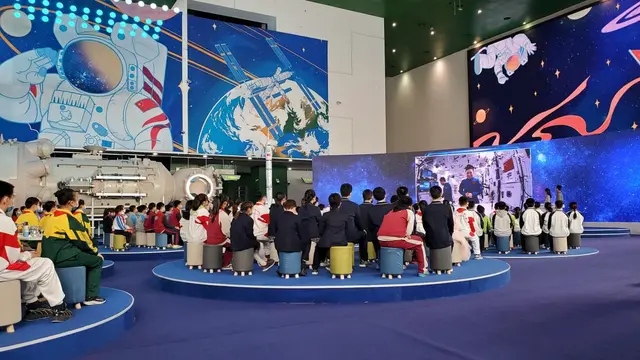China's Shenzhou-13 crew members Zhai Zhigang, Wang Yaping and Ye Guangfu livestreamed the first science lecture from the country's space station on Thursday afternoon, which amazed numerous students on Earth.
The lecture started at 3:40 p.m. (Beijing Time) and lasted about 45 minutes. A total of 1,420 primary and middle school students attended the lecture from five classrooms across China. The primary one was at the China Science and Technology Museum in Beijing. The other four were in Nanning City in south China's Guangxi Zhuang Autonomous Region, Wenchuan County in southwest China's Sichuan Province, Hong Kong and Macao spacial administrative regions.
A tour of the space station
At the beginning of the class, Wang, the first female taikonaut to enter China's space station, gave the students a tour of their living and working areas with the assistance of her two male crewmates.
She showcased their bedrooms and toilet, a fully functional kitchen where the taikonauts prepare their meals each day, the area where they conduct scientific experiments and their fitness equipment, including a treadmill and a spin bike.
In the kitchen, she showed the students a microwave, a water dispenser and a mini-refrigerator from which she took out a fresh apple.
In response to a Hong Kong student's question about water, Wang said the water they drink is recycled, noting that there is no difference in taste between regular and recycled water. With a water recycling system, full use is made of every drop of water in the space station, she said.
Scientific experiments in a zero-gravity setting
After the tour, the trio demonstrated several scientific experiments under zero-gravity conditions.
First, Ye demonstrated experiments related to cell growth in the weightless environment in space with a video clip. They compared the growth and shape of cells in artificial gravity and zero-gravity to study their changing rules and mechanisms.
Ye showed the students images of myocardial cells observed under a fluorescence microscope.
"They look amazing in space, as if they are beating," he said, explaining that the beating and gleaming occurred as the living cells had a bioelectrical reaction.
Ye and Wang then demonstrated and explained why astronauts cannot walk in space like they did on the ground and how angular momentum helps them turn around in zero gravity.
The team also conducted an experiment to show how lack of gravity causes loss in buoyancy, an optics experiment using water refraction and explored effervescence in a weightless environment using a water ball.
The Shenzhou-13 crew went into space aboard the Shenzhou-13 spaceship and entered the Tianhe core module on October 16, embarking on their six-month stay in space, which is China's longest-ever crewed mission so far.
This is the second space lecture given by taikonauts. In June 2013, Wang Yaping, assisted by the other two crew members on the Shenzhou-10 spacecraft, delivered the country's first live space lecture to over 60 million teachers and schoolchildren across China.
Source:CGTN
 简体中文
简体中文

